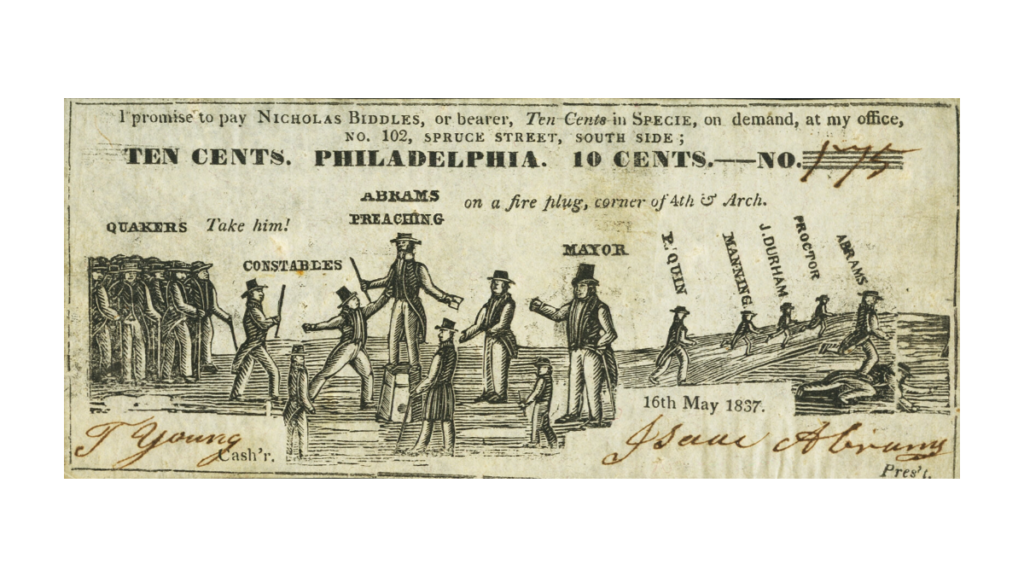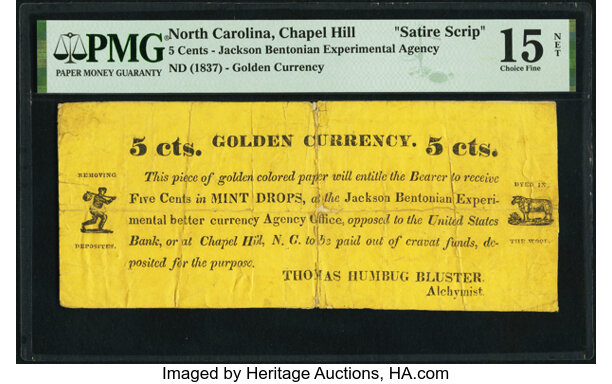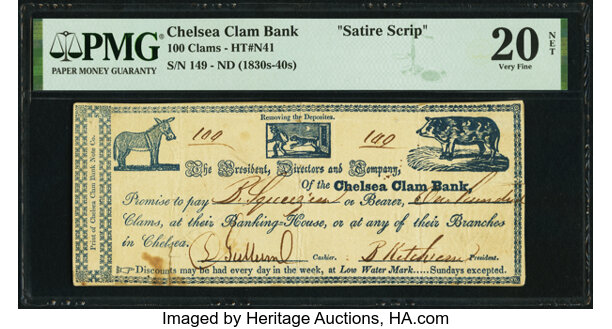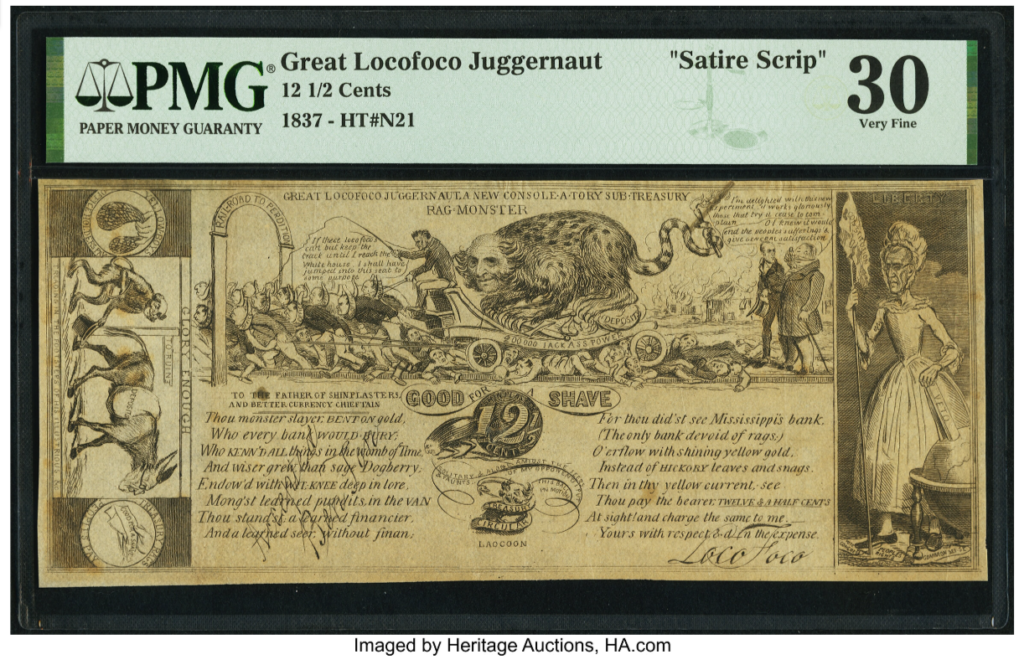
Paper money and pieces that look like paper money have historically served as the platform for airing political and economic views. In the United States, for example, colonial paper money made extensive use of patriotic emblems and mottos to promote independence and resistance. More recently, so-called notgeld notes, which offered thousands of distinctive designs and themes, were issued in post-World War I Germany. Many of these notes served as tiny billboards for messages decrying real and perceived wrongs endured by the nation in the years following the War to End All Wars, often in a humorous or satirical fashion.
The period in United States history known as the Panic of 1837 or Hard Times resulted in the issue of a large number of both tokens and paper money look-alikes that were used to attack the Government policies and practices of that era.
Featured Image: Philadelphia, PA- Isaac Abrams 10¢ Satirical Scrip May 16, 1837 Rulau HT-N26 PMG Very Fine 30.
In early 1832, President Andrew Jackson vetoed an attempt, led by Henry Clay, Daniel Webster, and Nicholas Biddle, President of the Bank of the United States, to preemptively recharter the institution four years before its charter was due to expire in 1836. Jackson viewed the bank as corrupt, unconstitutional, and a tool used by the rich and powerful to control both the economic and political future of the country. The Bank of the United States soon became the focus of the 1832 election, with Jackson winning a second term despite strong support, both financially and otherwise, of Henry Clay by the bank. Believing he had a mandate from the American electorate, Jackson embarked on an aggressive campaign to further weaken the Bank of the United States in 1833. This precipitated the so-called Bank War which saw Jackson swiftly remove Federal deposits from the Bank of the United States and place them with dozens of state-chartered commercial banks which soon came to be known as Jackson’s Pet Banks because many of them were well-connected politically with the administration. In 1834, the Senate censured Jackson, but the House of Representatives affirmed his actions; all of this along party lines. The battle raged on until February 11. 1836 when the Bank of the United States began operating with a Pennsylvania state charter, avoiding closing. The bank suspended specie payments in 1839 and failed in April 1841.
During the Jackson administration and the beginning of the Van Buren administration, the nation enjoyed relatively high prosperity, with rising agricultural prices and a speculative bubble in land prices. Banks were quite willing to make loans and the inevitable specter of inflation appeared. In reaction to this inflation, the so-called Specie Circular, issued by the Treasury Department on July 11, 1836, mandated that purchases of public lands (320 Acres or more) be made only in gold or silver coin after August 16, 1836 (December 15, 1836, for smaller purchases or for purchases made by settlers as opposed to speculators). This action burst the land speculation bubble and caused a cascade of bank failures and loan foreclosures, leading to a drop in agricultural prices. This forced many farmers and planters to default on loans that they could not repay. Soon a general recession, bordering on depression was in full force.
The nation’s dire financial situation soon led to both traditional protests and the use of (usually) satirical tokens and paper money lambasting Jackson, Martin Van Buren, who followed the same policies as his predecessor, and the nation’s financial situation in general.
This is one of the largest offerings of these historic notes in recent memory and includes a number of both interesting and rare examples. Many of these notes have very complex messages and imagery that require extended study to fully appreciate. Some have persons identified whose names have been subsequently lost to history. These notes are typically rare, with only a few surviving examples, because they were really bank note look-alikes rather than actual bank notes. Once the message had been read, the vast majority were simply discarded and so each note tends to be a minor (and often major) miracle of survival.
Highlights from the 2023 January 11 – 13 FUN Currency Signature® Auction #3591
See the samples below of scrip notes for sale, or view all the lots in this auction.
Chapel Hill, NC- “Golden Currency” 5¢ Satirical Scrip ND (ca. 1837) Rulau HT-N42 PMG Choice Fine 15 Net.

Some of the highlights include a possibly unique note from Chapel Hill, NC. Printed on bright yellow paper, this “Golden Currency” note takes a dig at Jackson and Senator Thomas Hart Benton for opposing the recharter of the Bank of the United States. Benton graduated from the University of North Carolina at Chapel Hill, undoubtedly accounting for the purported issue city on this note. It also features a small vignette of a man fleeing with a bundle on his shoulder labeled “REMOVING DEPOSITES” referring to Jackson’s move to shift federal deposits to the so-called Pet Banks from the Bank of the United States in 1833.
The Pinnacle of Satire Notes – Chelsea, (Unknown)- Chelsea Clam Bank 100 Clams Satirical Note Rulau HT-N41 PMG Very Fine 20 Net.
Another note in the collection is also believed to be unique. Issued by the “Chelsea Clam Bank,” which promised to pay the bearer 100 Clams, it features a vignette clearly aimed at Andrew Jackson depicting a thief with a sack on his back clearly titled Removing the Deposites being pursued in the middle of the night by a bank security dog. The other vignettes are those of a (Democratic) donkey and a pig. With a well -documented provenance, this note traces its history back at least five decades.
Great Locofoco Juggernaut 12-1/2¢ Satirical Note ND (ca. 1837) Rulau HT-N21 PMG Very Fine 30.
One of the most graphically complex notes in the collection pulls no punches in attacking both Jackson and Van Buren. In the center vignette, Martin Van Buren is depicted as a cat-like creature being pulled on a wagon full of deposits toward an arch labeled Rail Road to Perdition. Another vignette features an animal resembling Martin Van Buren slinking behind a donkey, carrying saddle bags marked DEPOSITS, whose face appears to be that of Jackson. The road they are travelling on has a sign pointing to RUIN. The note’s third vignette depicts Jackson, dressed in a woman’s clothing holding a tattered flag labelled CONSTITUTION and holding what appears to be a fan labelled VETO, standing on trampled papers labelled CONGRESS VOTES, PEOPLE’S RIGHTS, and COMMON SENSE.
This is just a small sample of the notes that are part of the most important collection of Hard Times satirical notes to appear in decades.




Leave a Comment